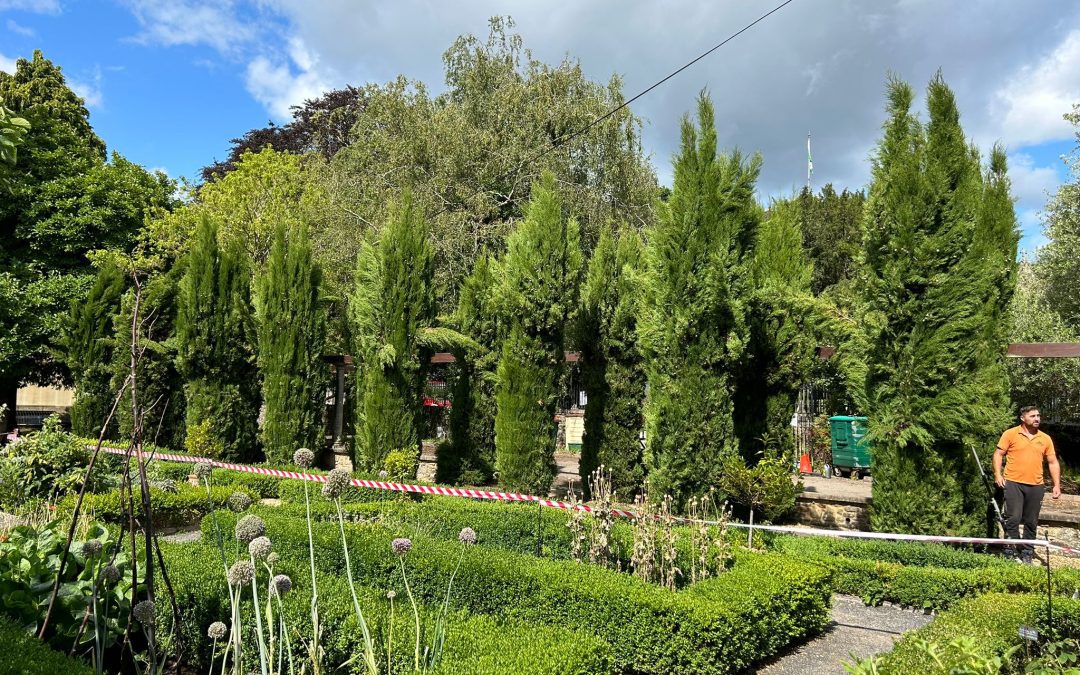- The Art of Tree Shaping for Impressive Landscape Aesthetics: A Cardiff Gardener’s Guide - May 11, 2024
- An Introduction to Tree Services and What We Do: Insight into Tree Work and Tree Care - November 18, 2023
- A Comprehensive Guide to Tree Services In Cardiff: Care, Removal, and Maintenance - August 17, 2023
Tree shaping, an artistic technique that manipulates living trees into desired shapes, might be just what you’re looking for to develop your garden’s look. This ancient practice is not only a beautiful addition to your world but it also promotes healthy growth for your trees.
In Cardiff, South Wales, tree shaping has become a popular method for enhancing the aesthetics of both public and private spaces. But how does one start this fascinating gardening journey? Here at Greenleaf Tree & Property Services, we’ve decided to offer some thoughts. Read on to learn more!
We’ll Talk About
- How tree shaping combines art and science to manipulate living trees into beautiful and unique shapes, enriching the aesthetics of any landscape.
- How historically, tree shaping was a practical tool used in many cultures but it has evolved into a modern form of art, manifesting in various styles including arbour sculpture, pleaching, and espalier.
- Why tree shaping not only elevates a garden’s visual appeal but also contributes to environmental conservation by fostering biodiversity and mitigating adverse weather conditions.
- Formative pruning, grafting for design, and the use of supports and frames stand as the main techniques in tree shaping, each contributing to creating unique and perpetually evolving structures.
- Why the success of tree shaping is contingent upon the choice of the right tree species, precise timing (usually during active growth phases), and diligent maintenance for the health of the trees.
- Why tree shaping proves to be equally applicable in public spaces and private gardens, adding value by transforming regular landscapes into liveable art exhibits.
- How, with a futuristic lens, tree shaping holds immense potential in sustainable design and architecture, paving the way for eco-friendly alternatives to traditional building methods.
What Is Tree Shaping?
Tree shaping, at its core, unifies two key aspects: art and science. It’s a technique which requires not only creativity but also in-depth knowledge of tree physiology.
The Art and Science of Tree Shaping
Tree shaping isn’t a mere artistic pursuit; it’s a blend of the aesthetic with the scientific, where practitioners must understand individual tree species and their growth patterns. Considering the artistically inclined, tree shaping provides an outlet for expressing creativity through arranging branches, trunks, and leaves into delightful designs. On the scientific side, it involves a deep understanding of how trees grow, which parts can be manipulated, and the degree of manipulation that a tree can withstand.
In effect, tree shaping turns a world into a living sculpture. It’s an ongoing process, keeping gardeners engaged as their creations mature. For instance, observe the aerial walkway of trees in Germany, where trunks and branches form a coherent unit—making gardens seem like galleries showcasing living art.
Historical Context of Tree Shaping
Digging deeper into this unique gardening practice’s roots, you’ll find a rich historical context. Tree shaping, in many cultures, was a traditional technique practiced for practical reasons, not just aesthetics. In the past, tree shaping had been used to create functional items, like bridges and ladders, by indigenous communities in India. Then, it evolved into an art form in the 20th century when artists such as Axel Erlandson, transformed trees into ‘living sculpture gardens’.
From there, this gardening practice has evolved and diversified, with various styles and methodologies emerging over time. Notable kinds include arbour sculpture, pleaching, and espalier, each offering unique artistic and practical value.
In Cardiff, South Wales, this practice has found widespread application in enhancing public and private spaces’ aesthetics. Today it’s seen as an intriguing, immersive art form—integrating science with aesthetics, while simultaneously offering environmental benefits.
In essence, tree shaping is deeply rooted in human history and continues to grow. It’s more than an art form; it’s a testament to human ingenuity that has travelled through time to become an integral part of modern gardening and landscaping aesthetics.
The Benefits of Tree Shaping in Landscape Aesthetics
Championing the use of tree shaping, Cardiff’s landscapes showcase how the practice uplifts aesthetics, augments biodiversity, and fortifies psychological wellbeing. Exploring this trifocal perspective, let’s investigate its various benefits.
Enhancing the Visual Appeal of Gardens
Tree shaping elevates the aesthetics of landscapes by providing a unique visual element. They offer a pleasurable sight, their transformation from ordinary trees to art pieces capturing public interest. For instance, in parks and private residences across Cardiff, shaped trees often serve as the star feature, blending seamlessly with other elements of world design. These living sculptures convey a timeless beauty that radiates throughout each season, their foliage, branches, and trunks contributing to an ever-changing tableau of colours, textures, and forms.
Environmental Benefits and Biodiversity
Advocating for eco-friendliness, tree shaping strikes a balance between nature and art without disrupting the ecosystem. Unlike regular sculptures, shaped trees continue to photosynthesize, sequester carbon, and produce oxygen. They improve air quality, reduce noise pollution, and attenuate harsh weather conditions. Also, they nurture biodiversity, providing habitats for various birds, insects, and small mammals. For example, pleached trees in Cardiff’s parks become nesting sites for birds during spring, aiding in local species conservation.
Psychological and Health Benefits
Tree shaping isn’t just about beautifying landscapes; it’s also about promoting psychological and health benefits. Interacting with nature, including tree-shaped art, helps reduce stress, increase focus, and promote a sense of well-being. Step into a park adorned with shaped trees and you’ll feel an instant calming effect, a sanctuary from the hustle and bustle of city life. In this context, shaping trees becomes a practised meditation, a therapy, a way of connecting with the rhythm of nature – it’s gratifying, serene and rewarding.
Basic Techniques in Tree Shaping
In this section, we’ll investigate three of the most important techniques used in tree shaping: formative pruning, grafting for design, and the use of supports and frames. These methods, practised by tree-shaping specialists in the UK and around the world, significantly aid in enhancing world aesthetics.
Formative Pruning
Formative pruning, a popular technique used in tree shaping, stems from selectively removing tree branches to control the tree’s growth pattern. This practice encourages a strong, long-lasting structure, reducing the risk of branch or stem breakage. For example, formative pruning in action can be seen in the famed Royal Botanic Gardens, Kew, where trees are deliberately shaped to form beautiful archways and walkways.
Grafting for Design
Grafting for design is another technique in the toolbox of tree shapers. This art involves merging tissues from two separate trees, bringing about a seamless intergrowth between them. This type of grafting lets architects design unique structures like botanical benches, humanlike figures, and maze walls. One example comes from the town of Gilroy, California, where the world’s foremost grafting project, the “Circus Trees”, stands as a testament to the capabilities of grafting for design.
Using Supports and Frames
Tree shapers often use supports and frames to guide the development of a tree’s structure. Shapers strategically position these supports around a young tree to guide its growth, creating visually striking forms that wouldn’t naturally occur. Examples can be found in the many public parks across Cardiff, where magnificent tree structures offer both a meeting point and a stirring work of art.
Tree Shaping Considerations and Best Practices
Moving from the broader context of tree shaping’s significance in aesthetic landscaping, let’s investigate into the fundamental considerations and best practices for effective tree shaping.
Choosing the Right Tree Species
Selecting an appropriate tree species stands as your first step into the area of tree shaping. Recognize, not every tree species displays an equal capacity to endure shaping. Some trees, such as willows, poplars, and elms, offer pliability and resilience, making them ideal candidates for shaping. Contrastingly, other species, like oak or pine, demonstrate less flexibility, hindering their suitability for elaborate designs. Striking examples exist in Cardiff’s city parks, where you’ll mostly spot shaped specimens of pliable willow, exemplifying wise species choice.
Timing: When to Shape Trees
Delving into the timing aspect, choose your tree-shaping moment wisely. Tree shaping usually coincides with the period of active growth, commonly the spring season. For instance, arbor sculptors at the Royal Botanic Gardens, Kew, regularly begin shaping efforts during late winter or early spring. Initiate shaping during this period, ensuring a better grip over the tree’s growth trajectory.
Maintenance: Keeping Your Tree Shapes Healthy
Maintaining the health of your shaped trees involves regular scrutiny and prompt action. Frequent checks for signs of disease, pests, or environmental stress contribute to the prolonged lifespan and continued aesthetic appeal of your living sculptures. For instance, tree shapers in Cardiff’s public parks ensure a vigilant maintenance schedule, enabling their shaped trees to thrive and contribute to the overall world’s aesthetics. Also, carry out a suitable watering, fertilising, and pruning regime considering the tree’s species and growth stage. Following such maintenance practices, you’ll undoubtedly witness your tree-shaping efforts bear fruit, enhancing your world’s visual charm.
Creative Applications of Tree Shaping
Explore how this unique blend of art and science gets utilised creatively in various spaces enhancing aesthetics and adding value.
Tree Shaping in Public Spaces
Discover how public spaces get transformed into liveable art exhibits, increasing their aesthetic and ecological appeal. As exemplified in some Cardiff public parks, tree shaping isn’t just an art form, it’s a tool that allows city planners and world artists to imbue urban areas with a touch of natural beauty. Plus, tree shaping can contribute positively towards fighting the adverse effects of urban heat islands, a common issue in cities worldwide. For instance, expansive tree canopies, created using skills like pleaching and grafting, offer much-needed shade and help moderate temperatures.
Functional Art: Tree Shaping in Private Gardens
Tree shaping isn’t restricted to public spaces. It’s an art form that many individuals embrace for their private gardens. Be it a beautifully sculpted hedge or an intricately shaped tree providing shade, the results are functional pieces of living art. Not only do these pieces add an element of whimsy to the garden, but also aid in creating private green spaces. Shaped trees and shrubs, such as spiral-shaped junipers, can act as effective windbreaks, creating comfortable outdoor living spaces.
Futuristic Tree Architecture: Potential and Possibilities
Investigate the visionary world of futuristic tree architecture where the line between the built and natural area blurs. Tree shaping holds immense potential in the creation of sustainable designs and structures. Initiatives like man-made tree houses or tree-shaped structures that integrate seamlessly into the environment mirror the possibilities of how humans can harness tree-shaping capabilities. Companies globally are embarking on this journey, investigating how living trees can be shaped into furniture and buildings, providing a sustainable solution to traditional architecture. Predictably, as our awareness of environmental issues grows, so does the appeal of tree-shaped architecture.
Final Thoughts from Us
So, you’ve journeyed through the intriguing area of tree shaping, from its historical roots to its transformative impact on public and private spaces. You’ve seen how this art form isn’t just about aesthetics, but also about fostering biodiversity and promoting well-being. You’ve learnt about key techniques like formative pruning and grafting, and their role in enhancing tree beauty. You’ve discovered how tree shaping is not just confined to gardens, but is also a creative solution for urban heat issues.
You’ve also glimpsed into the future of tree architecture, where sustainable designs are created using living trees. It’s clear that tree shaping is more than an art form, it’s a way of life that encourages us to live in harmony with nature. So why not incorporate tree shaping into your own world? It’s not just about making your surroundings more beautiful, it’s about making a positive impact on the environment too.




